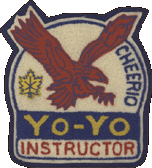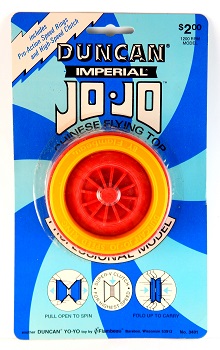                |
 |
 Sponsors and Curators Sponsors and Curators
The Museum of Yo-Yo History is a labor of love, and we would not be able to stay up-to-date with exhibits without the support of our sponsors and curators. Big thanks go to One Drop Design and Duncan for supplying us with their latest models, YoYoExpert for their help and support, and to Cody Orr, TotalArtist and YoYoBrothers™ for allowing us to use their collections!
If you're a manufacturer, or just a big collector and you want to help support the Museum drop me at line at chimera@yoyomuseum.com
|
 |
 |
 |
|
|
 |
| Duncan Jo-Jo Imperial - 3401 model |
| Exhibit #3929 |
 |
 |
| Type | Production |
| Shape | Standard (-) |
| Axle | Fixed |
| Packaging | Bubble Carded |
| Construction | Multi-piece plastic |
| Condition | Mint in Package |
| Date | 1972 |
| To | 1977 |
| Owner | Rick Brough |
| Compare |  |
|
|
The Duncan Jo-Jo Imperial was branded as a Chinese flying top, sometimes also known as a diabolo but on a much smaller scale.
Interestingly, the profile of the yo-yo is very similar to many 4A off-string yo-yos of today. Little did Duncan know that they were actually years ahead of their time with the product. This innovative design let you pull the sides out to expand it for play, then collapse the sides to carry it in your pocket. This model likely came out in the early to mid 1970s, based on the Duncan bubble card style, the pre-printed price of $2.00, and the fact that there is no bar code on the back. Unlike the late 1970s version, it did not come with a trick sheet; instead, the tricks were printed on the back of the card.
Notice that the Jo-Jo has By Flambeau and Duncan Jo-Jo Speed Ring molded into the face of the yellow ring. The Imperial was considered the Professional model in the product line-up. This unusual Duncan product line also included the Duncan Jo-Jo Special and the Duncan Jo-Jo Beginner.
Of historial interest...
There is an odd, urban legend-like story that continues to circulate on the internet about this unusual Duncan product. Supposedly, sales of the Jo-Jo were poor (though during what period of time is not made clear by whomever is telling the story) so Duncan decided to pull all the product from store shelves and have it destroyed. This piece of fiction has never been verified by a primary source or by anyone from Duncan/Flambeau. It makes little sense that Duncan would spend all the time, money, and resources to design, produce, market, and sell three different Jo-Jo models: Imperial, Special, and Beginner. These designs were unlike anything Duncan had ever made before. Now consider the new tricks that had to also be developed. Then there was new packaging that had to be designed and created. All these processes are not trivial things to make a new toy line. It all costs time and money.
It should also be noted that Duncan created new packaging for the Jo-Jo Imperial a year or two later (see the Duncan Jo-Jo Imperial from the late 1970s), after the initial release of the Jo-Jo Imperial seen in this exhibit. That alone suggests that the Jo-Jo (at least the Imperial version) sold reasonably well. It also helps explain why Duncan Jo-Jos still occasionally show up on auction sites, and are still found in their original packaging after all these years.
What certainly does not make sense is that Duncan – aledgedly disappointed by poor sales of the Jo-Jo after nearly a decade – would remove all product from store shelves and have it completely destroyed. That thinking makes no sense whatsoever.
If you have a primary source to verify the history of this short-lived product line, let us know!
Original retail price: $2 US |  |
| |
|
 |
|
 |
|
|
 |
|
|
 |
 |
|

